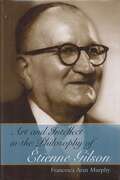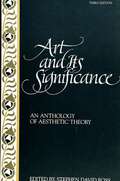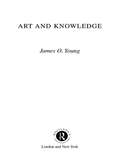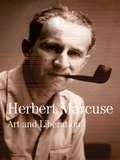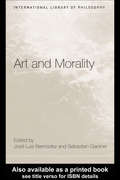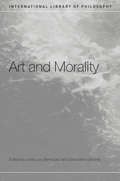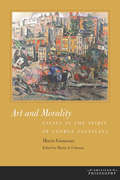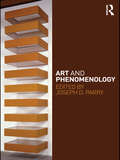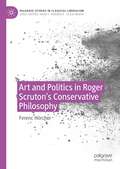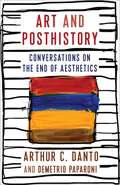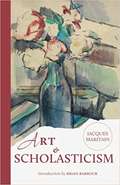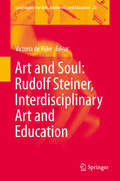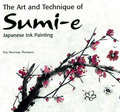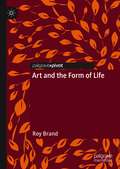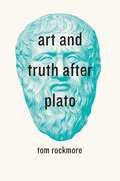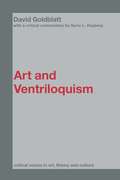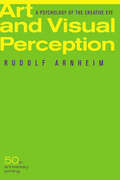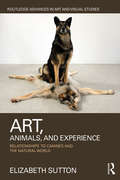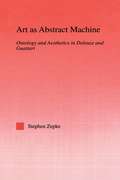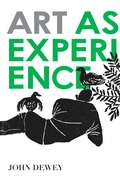- Table View
- List View
Art and Intellect in the Philosophy of Étienne Gilson (The Eric Voegelin Institute Series in Political Philosophy #Volume One)
by Francesca Aran MurphyIn Art and Intellect in the Philosophy of Étienne Gilson, Francesca Aran Murphy tells the story of this French philosopher’s struggle to reconcile faith and reason. In his lifetime, Gilson often stood alone in presenting Saint Thomas Aquinas as a theologian, one whose philosophy came from his faith. Today, Gilson’s view is becoming the prevalent one. Murphy provides us with an intellectual biography of this Thomist leader throughout the stages of his scholarly development. <p><p>Murphy covers more than a half century of Gilson’s life while reminding readers of the political and social realities that confronted intellectuals of the early twentieth century. She shows the effects inner-church politics had on Gilson and his contemporaries such as Alfred Loisy, Lucien Lévy Bruhl, Charles Maurras, Henri de Lubac, Marie-Dominique Chenu, and Jacques Maritain, while also contextualizing Gilson’s own life and thoughts in relation to these philosophers and theologians. <p><p>These great thinkers, along with Gilson, continue to be sources of important intellectual debate among scholars, as do the political periods through which Gilson’s story threads—World Wars I and II, the rise and fall of Fascism, and the political upheavals of Europe. By placing Gilson’s twentieth-century Catholic life against a dramatic background of opposed political allegiances, clashing spiritualities, and warring ideas of philosophy, this book shows how rival factions each used their own interpretations of Thomas Aquinas to legitimate their conceptions of the Catholic Church. <p><p>In Art and Intellect in the Philosophy of Étienne Gilson, Murphy shows Gilson’s early openness to the artistic revolution of the Cubist and the Expressionist movements and how his love of art inspired his existential theology. She demonstrates the influence that Henri Bergson continued to have on Gilson and how Gilson tried to bring together the intellectual, Dominican side of Christianity with the charismatic, experiential Franciscan side. <p><p>Murphy concludes with a chapter on issues inspired by the Gilsonist tradition as developed by recent thinkers. This volume makes an original contribution to the study of Gilson, for the first time providing an organic and synthetic treatment of this major spiritual philosopher of modern times.
Art and Its Significance: An Anthology of Aesthetic Theory, Third Edition
by Stephen David RossThis anthology has been significantly expanded for this edition to include a wider range of contemporary issues. The most important addition is a new section on multicultural theory, including important and controversial selections ranging from discussions of art in other cultures to discussions of the appropriation of nonWestern art in Western cultures.The material from Kant's Critique of Judgment has been expanded to include his writing on aesthetical ideas and the sublime. The selections from Derrida have been updated and considerably expanded for this edition, primarily from The Truth in Painting. One of Derrida's most interesting provocations has also been added, his letter to Peter Eisenman on architecture. In addition, the section on feminist theory now includes a chapter from Irigaray's Speculum of the Other Woman.The anthology includes the most important writings on the theory of art in the Western tradition, including selections from Plato, Aristotle, Hume, Kant, Hegel, and Nietzsche; the most important philosophical writings of the last hundred years on the theory of art, including selections from Collingwood, Langer, Goodman, Heidegger, and Merleau-Ponty; contemporary Continental writings on art and interpretation, including selections from Gadamer, Ricoeur, Derrida, Lyotard, and Foucault; also writings on the psychology of art by Freud and Jung, from the Frankfurt School by Benjamin, Adorno, and Marcuse, in feminist theory, multiculturalism, and postmodernism. The anthology also includes twentieth-century writings by artists including discussions of futurism, suprematism, and conceptual art.Stephen David Ross is Professor of Philosophy and Comparative Literature, State University of New York at Binghamton.
Art and Knowledge
by James O. YoungAlmost all of us would agree that the experience of art is deeply rewarding. Why this is the case remains a puzzle; nor does it explain why many of us find works of art much more important than other sources of pleasure. Art and Knowledge argues that the experience of art is so rewarding because it can be an important source of knowledge about ourselves and our relation to each other and to the world. The view that art is a source of knowledge can be traced as far back as Aristotle and Horace. Artists as various as Tasso, Sidney, Henry James and Mendelssohn have believed that art contributes to knowledge. As attractive as this view may be, it has never been satisfactorily defended, either by artists or philosophers. Art and Knowledge reflects on the essence of art and argues that it ought to provide insight as well as pleasure. It argues that all the arts, including music, are importantly representational. This kind of representation is fundamentally different from that found in the sciences, but it can provide insights as important and profound as available from the sciences. Once we recognise that works of art can contribute to knowledge we can avoid thorough relativism about aesthetic value and we can be in a position to evaluate the avant-garde art of the past 100 years. Art and Knowledge is an exceptionally clear and interesting, as well as controversial, exploration of what art is and why it is valuable. It will be of interest to all philosophers of art, artists and art critics.
Art and Liberation: Collected Papers of Herbert Marcuse, Volume 4 (Herbert Marcuse: Collected Papers #4)
by Herbert MarcuseThe role of art in Marcuse’s work has often been neglected, misinterpreted or underplayed. His critics accused him of a religion of art and aesthetics that leads to an escape from politics and society. Yet, as this volume demonstrates, Marcuse analyzes culture and art in the context of how it produces forces of domination and resistance in society, and his writings on culture and art generate the possibility of liberation and radical social transformation. The material in this volume is a rich collection of many of Marcuse’s published and unpublished writings, interviews and talks, including ‘Lyric Poetry after Auschwitz’, reflections on Proust, and Letters on Surrealism; a poem by Samuel Beckett for Marcuse’s eightieth birthday with exchange of letters; and many articles that explore the role of art in society and how it provides possibilities for liberation. This volume will be of interest to those new to Marcuse, generally acknowledged as a major figure in the intellectual and social milieus of the 1960s and 1970s, as well as to the specialist, giving access to a wealth of material from the Marcuse Archive in Frankfurt and his private collection in San Diego, some of it published here in English for the first time. A comprehensive introduction by Douglas Kellner reflects on the genesis, development, and tensions within Marcuse’s aesthetic, while an afterword by Gerhard Schweppenhäuser summarizes their relevance for the contemporary era.
Art and Morality (International Library of Philosophy)
by José Luis Bermúdez Sebastian GardnerArt and Morality is a collection of groundbreaking new papers on the theme of aesthetics and ethics, and the link between the two subjects. A group of distinguished contributors tackle the important questions that arise when one thinks about the moral dimensions of art and the aesthetic dimension of moral life.The volume is a significant contribution to philosophical literature, opening up unexplored questions and shedding new light on more traditional debates in aesthetics. The topics explored include: the relation of aesthetic to ethical judgement; the relation of artistic experience to moral consciousness; the moral status of fiction; the concepts of sentimentality and decadence; the moral dimension of critical practice, pictorial art and music; the moral significance of tragedy; and the connections between artistic and moral issues elaborated in the writings of central figures in modern philosophy, such as Kant, Schopenhauer and Nietzsche. The contributors share the view that progress in aesthetics requires detailed study of the practice of criticism. This volume will appeal both to the philosophical community and to researchers in areas such as literary theory, musicology and the theory of art.
Art and Morality (International Library Of Philosophy Ser.)
by Sebastian GardnerFeaturing contributions from Matthew Kieran, Aaron Ridley, Roger Scruton and Mary Mothersill to name but a few, this collection of groundbreaking new papers on aesthetics and ethics, highlights the link between the two subjects. These leading figures tackle the important questions that arise when one thinks about the moral dimensions of art and the aesthetic dimension of moral life.The volume is a significant contribution to philosophical literature, opening up unexplored questions and shedding new light on more traditional debates in aesthetics. The topics explored include:the relation of aesthetic to ethical judgment the relation of artistic experience to moral consciousnessthe moral status of fictionthe concepts of sentimentality and decadencethe moral dimension of critical practice, pictorial art and musicthe moral significance of tragedythe connections between artistic and moral issues elaborated in the writings of central figures in modern philosophy, such as Kant, Schopenhauer and Nietzsche.The contributors share the view that progress in aesthetics requires detailed study of the practice of criticism. This volume will appeal to both the philosophical community and to researchers in areas such as literary theory, musicology and the theory of art.
Art and Morality: Essays in the Spirit of George Santayana (American Philosophy)
by Morris Grossman Martin A. ColemanThe guiding theme of these essays by aesthetician, musician, and Santayana scholar Morris Grossman is the importance of preserving the tension between what can be unified and what is disorganized, random, and miscellaneous. Grossman described this as the tension between art and morality: Art arrests a sense of change and yields moments of unguarded enjoyment and peace; but soon, shifting circumstances compel evaluation, decision, and action. According to Grossman, the best art preserves the tension between the aesthetic consummation of experience and the press of morality understood as the business of navigating conflicts, making choices, and meeting needs.This concern was intimately related to his reading of George Santayana. The best philosophy, like the best art, preserves the tension between what can be ordered and what resists assimilation, and Grossman read Santayana as exemplifying this virtue in his embrace of multiple perspectives. Other scholars have noted the multiplicity or irony in Santayana’s work, but Grossman was unique in taking such a style to be a substantive part of Santayana’s philosophizing.
Art and Objects
by Graham HarmanIn this book, the founder of object-oriented ontology develops his view that aesthetics is the central discipline of philosophy. Whereas science must attempt to grasp an object in terms of its observable qualities, philosophy and art cannot proceed in this way because they don't have direct access to their objects. Hence philosophy shares the same fate as art in being compelled to communicate indirectly, allusively, or elliptically, rather than in the clear propositional terms that are often taken – wrongly – to be the sole stuff of genuine philosophy. Conceiving of philosophy and art in this way allows us to reread key debates in aesthetic theory and to view art history in a different way. The formalist criticism of Greenberg and Fried is rejected for its refusal to embrace the innate theatricality and deep multiplicity of every artwork. This has consequences for art criticism, making pictorial content more important than formalism thinks but less entwined with the social sphere than anti-formalism holds. It has consequences for art history too, as the surrealists, David, and Poussin, among others, gain in importance. The close link between aesthetics and ontology also invites a new periodization of modern philosophy as a whole, and the habitual turn away from Kant’s thing-in-itself towards an increase in philosophical "immanence" is shown to be a false dawn. This major work will be of great interest to students and scholars of philosophy, aesthetics, art history and cultural theory.
Art and Phenomenology
by Joseph D. ParryPhilosophy of art is traditionally concerned with the definition, appreciation and value of art. Through a close examination of art from recent centuries, Art and Phenomenology is one of the first books to explore visual art as a mode of experiencing the world itself, showing how in the words of Merleau-Ponty ‘Painting does not imitate the world, but is a world of its own’. An outstanding series of chapters by an international group of contributors examine the following questions: Paul Klee and the body in art colour and background in Merleau-Ponty’s phenomenology of art self-consciousness and seventeenth-century painting Vermeer and Heidegger philosophy and the painting of Rothko embodiment in Renaissance art sculpture, dance and phenomenology. Art and Phenomenology is essential reading for anyone interested in phenomenology, aesthetics, and visual culture.
Art and Politics in Roger Scruton's Conservative Philosophy (Palgrave Studies in Classical Liberalism)
by Ferenc HörcherThis book covers the field of and points to the intersections between politics, art and philosophy. Its hero, the late Sir Roger Scruton had a longstanding interest in all fields, acquiring professional knowledge in both the practice and theory of politics, art and philosophy. The claim of the book is, therefore, that contrary to a superficial prejudice, it is possible to address the philosophical issues of art and politics in the same oeuvre, as the example of this Cambridge-educated analytical philosopher proves.Accordingly, the book has a bold thesis on the general, theoretical level, mapping the connections between politics, art and philosophy. However, it also has a pioneering commitment on the level of the particular, offering the first full-length study into the philosophical legacy of Roger Scruton, probably the most important British conservative philosopher of the late 20th and the first decades of the 21st century. It also allows reader to look into the philosopher’s fascination with Central European art and culture. Finally, it also provides a daring analysis of the late Scruton’s metaphysical inspirations, connecting the arts, and especially music, with religion and the bonds of love.
Art and Posthistory: Conversations on the End of Aesthetics (Columbia Themes in Philosophy, Social Criticism, and the Arts)
by Arthur C. Danto Demetrio PaparoniFrom the 1990s until just before his death, the legendary art critic and philosopher Arthur C. Danto carried out extended conversations about contemporary art with the prominent Italian critic Demetrio Paparoni. Their discussions ranged widely over a vast range of topics, from American pop art and minimalism to abstraction and appropriationism. Yet they continually returned to the concepts at the core of Danto’s thinking—posthistory and the end of aesthetics—provocative notions that to this day shape questions about the meaning and future of contemporary art.Art and Posthistory presents these rich dialogues and correspondence, testifying to the ongoing importance of Danto’s ideas. It offers readers the opportunity to experience the intellectual excitement of Danto in person, speculating in a freewheeling yet erudite style. Danto and Paparoni discuss figures such as Andy Warhol, Marcel Duchamp, Franz Kline, Sean Scully, Clement Greenberg, Cindy Sherman, and Wang Guangyi, offering both insightful comments on individual works and sweeping observations about wider issues. On occasion, the artist Mimmo Paladino and the philosopher Mario Perniola join the conversation, enlivening the discussion and adding their own perspectives.The book also features an introductory essay by Paparoni that provides lucid analysis of Danto’s thinking, emphasizing where the two disagree as well as what they learned from each other.
Art and Posthumanism: Essays, Encounters, Conversations (Art After Nature)
by Cary WolfeA sustained engagement between contemporary art and philosophy relating to our place in, and responsibility to, the nonhuman world How do contemporary art and theory contemplate the problem of the &“bio&” of biopolitics and bioart? How do they understand the question of &“life&” that binds human and nonhuman worlds in their shared travail? In Art and Posthumanism, Cary Wolfe argues for the reconceptualization of nature in art and theory to turn the idea of the relationship between the human and the planet upside down.Wolfe explores a wide range of contemporary artworks—from Sue Coe&’s illustrations of animals in factory farms and Eduardo Kac&’s bioart to the famous performance pieces of Joseph Bueys and the video installations of Eija-Liisa Ahtila, among others—examining how posthumanist theory can illuminate, and be illuminated by, artists&’ engagement with the more-than-human world. Looking at biological and social systems, the question of the animal, and biopolitics, Art and Posthumanism explores how contemporary art rivets our attention on the empirically thick, emotionally charged questions of &“life&” and the &“living&” amid ecological catastrophe.One of the foremost theorists of posthumanism, Wolfe pushes that philosophy out of the realm of the purely theoretical to show how a posthumanist engagement with particular works and their conceptual underpinnings help to develop more potent ethical and political commitments.
Art and Scholasticism: with Other Essays
by Jacques MaritainArt and Scholasticism is Jacques Maritain’s classic argument for an objective view of both art and the artist. Maritain provides a strong dissenting perspective on the lazy, self-flattering artistic assumptions of the past two centuries. For this new edition, Brian Barbour’s Introduction gives a fascinating summary of Maritain’s philosophical background, his conversion to Catholicism and work in Thomistic thought, and the importance of Art and Scholasticism in understanding aesthetics—be it in poetry, painting, music, or literature. Art and Scholasticism is a must-read for lovers of art and wisdom alike
Art and Soul: Rudolf Steiner, Interdisciplinary Art and Education (Landscapes: the Arts, Aesthetics, and Education #25)
by Victoria De RijkeThis book brings together Steiner's philosophical, biodynamic and cultural contributions to education, where 'spirit' and ‘soul’ are the creative elements in human evolution. His thought is applied to selected examples of innovative artistic practice and pedagogy of the present. This volume is intended for researchers in the arts and education with an interest in Rudolf Steiner's huge influence on educational thought and policy.This is an urgent point in time to reflect on the role of arts in education and what it might mean for our souls. An accessible yet scholarly study of interdisciplinarity, imagination and creativity is of critical widespread interest now, when arts education in many countries is threatened with near-extinction.
The Art and Technique of Sumi-e Japanese Ink Painting
by Kay Morrissey ThompsonThe art of sumi-e, which literally means "ink picture," combines calligraphy and ink-painting to produce compositions of rare beauty. This beauty is paradoxical-ancient but modern, simple but complex, bold but subdued-no doubt reflecting the arts spiritual basis in Zen Buddhism. At the same time sumi-e is firmly rooted in the natural world, its various techniques serving as the painter's language for describing the wonders of nature.Art and Technique of Sumi-e Japanese Ink-Painting explores this ancient technique. Buddhist priests brought the ink stick and the bamboo-handled brush to Japan from China in the sixth century, and over the past fourteen centuries Japan has developed a rich heritage of ink-painting. Today the artistry of sumi-e can be admired in books, reproductions and museums, but the techniques of the art have been much less accessible. As a result, little information has been available to the inquisitive Western artist attracted to ink-painting. This book, designed to help remedy that deficiency, is the product of the author's study with her teacher, Ukai Uchiyama, master calligraphist and artist.
Art and the Church: Ecclesiastical Encounters with Contemporary Art
by Jonathan Koestle-CateA vibrant critical exchange between contemporary art and Christianity is being increasingly prompted by an expanding programme of art installations and commissions for ecclesiastical spaces. Rather than 'religious art' reflecting Christian ideology, current practices frequently initiate projects that question the values and traditions of the host space, or present objects and events that challenge its visual conventions. In the light of these developments, this book asks what conditions are favourable to enhancing and expanding the possibilities of church-based art, and how can these conditions be addressed? What viable language or strategies can be formulated to understand and analyse art's role within the church? Focusing on concepts drawn from anthropology, comparative religion, art theory, theology and philosophy, this book formulates a lexicon of terms built around the notion of encounter in order to review the effective uses and experience of contemporary art in churches. The author concludes with the prognosis that art for the church has reached a critical and decisive phase in its history, testing the assumption that contemporary art should be a taken-for-granted element of modern church life. Art and the Church: A Fractious Embrace uniquely combines conceptual analysis, critical case studies and practical application in a rigorous and inventive manner, dealing specifically with contemporary art of the past twenty-five years, and the most recent developments in the church's policies for the arts.
Art and the Form of Life
by Roy BrandArt and the Form of Life takes a classic theme—philosophy as the art of living—and gives it a contemporary twist. The book examines a series of watershed moments in artistic practice alongside philosophers’ most enduring questions about the way we live. Coupling Tino Sehgal with Wittgenstein, cave art with Foucault, Stanley Kubrick with Nietzsche, and the Bauhaus with Walter Benjamin, the book animates the idea that life is literally ours to make. It reflects on universal themes that connect the long histories of art and philosophy, and it does so using a contemporary approach. Drawing on great philosophical works, it argues that life practiced as an art form affords an experience of meaning, in the sense that it is engaging, creative, and participatory. It thus effects a fundamental renewal of experience.
The Art and Thought of Heraclitus
by Charles H. KahnBehind the superficial obscurity of what fragments we have of Heraclitus' thought, Professor Kahn claims that it is possible to detect a systematic view of human existence, a theory of language which sees ambiguity as a device for the expression of multiple meaning, and a vision of human life and death within the larger order of nature. The fragments are presented here in a readable order; translation and commentary aim to make accessible the power and originality of a systematic thinker and a great master of artistic prose. The commentary locates Heraclitus within the tradition of early Greek thought, but stresses the importance of his ideas for topical theories of language, literature and philosophy.
Art and Truth after Plato
by Tom RockmoreDespite its foundational role in the history of philosophy, Plato's famous argument that art does not have access to truth or knowledge is now rarely examined, in part because recent philosophers have assumed that Plato's challenge was resolved long ago. In Art and Truth after Plato, Tom Rockmore argues that Plato has in fact never been satisfactorily answered--and to demonstrate that, he offers a comprehensive account of Plato's influence through nearly the whole history of Western aesthetics. Rockmore offers a cogent reading of the post-Platonic aesthetic tradition as a series of responses to Plato's position, examining a stunning diversity of thinkers and ideas. He visits Aristotle's Poetics, the medieval Christians, Kant's Critique of Judgment, Hegel's phenomenology, Marxism, social realism, Heidegger, and many other works and thinkers, ending with a powerful synthesis that lands on four central aesthetic arguments that philosophers have debated. More than a mere history of aesthetics, Art and Truth after Plato presents a fresh look at an ancient question, bringing it into contemporary relief.
Art and Truth after Plato
by Tom RockmoreDespite its foundational role in the history of philosophy, Plato’s famous argument that art does not have access to truth or knowledge is now rarely examined, in part because recent philosophers have assumed that Plato’s challenge was resolved long ago. In Art and Truth after Plato, Tom Rockmore argues that Plato has in fact never been satisfactorily answered—and to demonstrate that, he offers a comprehensive account of Plato’s influence through nearly the whole history of Western aesthetics. Rockmore offers a cogent reading of the post-Platonic aesthetic tradition as a series of responses to Plato’s position, examining a stunning diversity of thinkers and ideas. He visits Aristotle’s Poetics, the medieval Christians, Kant’s Critique of Judgment, Hegel’s phenomenology, Marxism, social realism, Heidegger, and many other works and thinkers, ending with a powerful synthesis that lands on four central aesthetic arguments that philosophers have debated. More than a mere history of aesthetics, Art and Truth after Plato presents a fresh look at an ancient question, bringing it into contemporary relief.
Art and Ventriloquism (Critical Voices in Art, Theory and Culture)
by David GoldblattThis exciting collection of David Goldblatt's essays, available for the first time in one volume, uses the metaphor of ventriloquism to help understand a variety of art world phenomena. It examines how the vocal vacillation between ventriloquist and dummy works within the roles of artist, artwork and audience as a conveyance to the audience of the performer's intentions, emotions and beliefs through a created performative persona. Considering key works, including those of Nietzsche, Foucault, Socrates, Derrida, Cavell and Wittgenstein, Goldblatt examines how the authors use the framework of ventriloquism to construct and negate issues in art and architecture. He ponders 'self-plagiarism'; why the classic philosopher cannot speak for himself, but must voice his thoughts through fictional characters or inanimate objects and works. With a close analysis of two ventriloquist paintings by Jasper Johns and Paul Klee, a critical commentary by Garry L. Hagberg, and preface by series editor Saul Ostrow, Goldblatt's thoroughly fascinating book will be an invaluable asset to students of cultural studies, art, and philosophy.
Art and Visual Perception, Second Edition: A Psychology of the Creative Eye
by Rudolf ArnheimSince its publication fifty years ago, this work has established itself as a classic. It casts the visual process in psychological terms and describes the creative way one's eye organizes visual material according to specific psychological premises. In 1974 this book was revised and expanded, and since then it has continued to burnish Rudolf Arnheim's reputation as a groundbreaking theoretician in the fields of art and psychology.
Art, Animals, and Experience: Relationships to Canines and the Natural World (Routledge Advances in Art and Visual Studies)
by Elizabeth SuttonElizabeth Sutton, using a phenomenological approach, investigates how animals in art invite viewers to contemplate human relationships to the natural world. Using Rembrandt van Rijn’s etching of The Presentation in the Temple (c. 1640), Joseph Beuys’s social sculpture I Like America and America Likes Me (1974), archaic rock paintings at Horseshoe Canyon, Canyonlands National Park, and examples from contemporary art, this book demonstrates how artists across time and cultures employed animals to draw attention to the sensory experience of the composition and reflect upon the shared sensory awareness of the world.
Art as Abstract Machine: Ontology and Aesthetics in Deleuze and Guattari
by Stephen ZepkeFirst Published in 2005. Routledge is an imprint of Taylor & Francis, an informa company.
Art as Experience
by John DeweyBased on John Dewey's lectures on esthetics, delivered as the first William James Lecturer at Harvard in 1932, Art as Experience has grown to be considered internationally as the most distinguished work ever written by an American on the formal structure and characteristic effects of all the arts: architecture, sculpture, painting, music, and literature.
